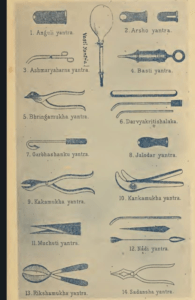Tagged: Ancient knowledge, Ayurveda, evolution., Healing, Hinduism, Medical, Medical practices, Sanatan Dharma, Spirituality. 5 minute reads
- This topic is empty.
-
AuthorPosts
-
June 7, 2023 at 11:06 pm #1313Up::1
The vast medical literature of ancient India remains yet unexplored. The Sushruta Samhita is an ancient text on medicine and surgeries and is one of the intrinsic texts of Ayurveda. It holds great medical importance as it holds records setting out the procedures of surgeries, instruments which is still abide by modern science. Sushruta belongs to the race of Vishvamitra. The Mahabharata shows him as the son of royal sage. Puranas outline Sushruta as a disciple of Dhanavantri, the first who proposed medical science. Sushruta Samhita as we have certainly not discovered the chronology of Sushruta. But he somewhere belongs to Satya Yuga. The ancient Aryans assert their knowledge from gods through revelation. Sushruta in his Samhita describes Ayurveda as a subdivision of the Atharvan, while others believed it has its origin in the verse of Rik Samhita.
Sushruta was rigidly a surgeon and Sushruta Samhita is the only ancient text which includes the problems of practical surgeries he ascribes the art of controlling a lancet or forceps. Vedic India acknowledged the principal division of labour among those involved in these healing practices of the human body and there were surgeons and physicians midwifery, paediatrics, sanitation were map out in the age of Veda.
In Rig Veda, the science involved in the amputation of legs which were replaced by iron substitutes, arrows and shafts were extracted from the limbs of the injured were mentioned and many difficult surgeries were successfully performed. Though the story of the progression of Ayurvedic surgery is long.
Sushruta dedicated his whole life to the pursuit of surgery and it was him who classified and grouped surgical operations as Aharya (extraction of solid bodies), Bhedya (excising), Chhedya (incising), Lekhya (scarifying), Sivya (suturing), Vedhya (puncturing) and visravaniya (evacuating fluids). He also recognises hundred and twenty five different instruments and equipment of surgeons are practically identical as recommended in at present.

Sushruta contributed in recognizing the art of cataracts which was unknown for a long span. Limbs amputation ,abdominal sections, fractures, removal of hernia, haemorrhoids and these methods were all suggested in Sushruta Samhita. Elaborate instructions regarding incision as well as care and the management of patients are clearly stated in the ancient text.
The Aitareya Brahmana describes the study of practical anatomy and the particular way of dividing organs. Sushruta as a biologist stated factors or laws that preside over the evolution of the physical aspect and physical evolution. Ayurvedic embryology and the factors vital for the development of the fetus from the time to the appearance of manual characteristics have been described in the verse of Rig Veda. In theories, Sushruta accepts the possibility of many children at a single conception. Sushruta’s writing on physiology is the same as one adopted by the Ayurveda schools Vayu, Pittam, and Kapham the three main physiological functions. However, with the right understanding of the concepts of ayurvedic medicines clear up the nature of these factors, the Vedic physician owned a significant knowledge of the process of gastric circulation,muscles, tendons.
Sushruta Samhita provides details on amputation, midwifery, ophthalmic surgery, dissection, lithotomic operation, andrology , gynecology, birth difficult labour, skin disease, food regimen of patients recovery. Also, it highlights the importance and classification of crude drugs into thirty seven groups.
Rigveda mentions thousands of drugs. Indeed the elements of embryology, paediatrics were put together in the age of the Vedas. Sushruta’s Samhita still invites the admiration of the world even after thousand of years of progress.
Attachments:
You must be logged in to view attached files. -
AuthorPosts
- You must be logged in to reply to this topic.